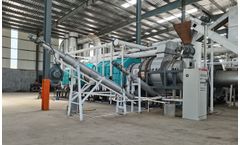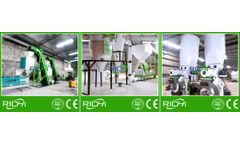Refine by
Biorefinery Articles & Analysis
28 articles found
From decentralized charcoal production units to integrated biorefineries, the future of sawdust charcoal promises decentralized charcoal production units to integrated biorefineries, the future of sawdust charcoal promises to be characterized by efficiency, versatility, and ecological integrity. ...
During 2010, KiOR began construction of their Columbus biorefinery, but also in 2014, announced it would idle the plant on account of financial challenges. The business eventually declared Chapter 11 bankruptcy and closed its doors. The Columbus biorefinery had not been incorporated into its bankruptcy filing. Although research articles have been published on ...
A look at the completed biorefinery project from December 2020. Constructed for Bogazici university in Turkey. ...
Along with fulfilling the demands of the three significant power terminals, power, electrical power as well as heat, bio-based materials can additionally be created to change petroleum-based materials, which is also impossible for various other renewable energy sources. Biorefinery based upon biomass sources is currently likewise emerging as a brand-new market to ...
Tata is formally entering into Biorefinery business. Clean-Energy is the biggest focus. The Generation involves Solar, Wind technologies coupled with Battery Storage Technology (Lithium ion and related technology). ...
The Lacombe Biorefinery project will serve as our first full demonstration facility for the BioRefinex technology, and therefore it will become the cornerstone of our business. ...
The energy sector is technology-intensive, and it has passed through several innovation-led transformations in the last two centuries The last 200 years of the history of energy could be characterised, without too much exaggeration, as five or six long periods of disruption and uncertainty, punctuated by moments of stability. The energy sector is technology-intensive, and it has passed through ...
” There has been a dramatic expansion in biorefineries, which transform biowaste and industrial by-products into useful materials. ...
The following presentations are available on the BETO website: Thermal and Catalytic Processing Capabilities at NREL -- Zia Abdullah, NREL Integrated Biorefinery Research Facility (IBRF) - Overview -- Zia Abdullah, NREL Process and Product Development with PNNL -- Corinne Drennan, Pacific Northwest National Laboratory (PNNL) Industry – Lab Success Stories -- Rick ...
While the broad scope of the conference has changed little over the years, some topics have expanded and developed more than others. Over recent years the biorefinery approach has grown in importance in order to maximize resource efficiency and indeed to improve financial performance, given the comparatively high value of some non-energy products of biomass (see Newsletter No. ...
An important research topic as a substantial part of a sustainable economy are biorefineries. Biorefinery refers to the facilities, which converts biomass into fuels, power, heat, chemicals and materials, food, and several other useful products. A biorefinery utilises different kinds of biomass, such as agricultural crops, wood, forest ...
” Projects funded through BRDI must address one of the foll owing topic areas: Feedstocks development: Research, development, and demonstration (RD&D) focused on feedstocks and feedstock logistics as it relates to the production of raw materials for conversion to biofuels and biobased products; Biofuels and biobased products development: RD&D focused on the development of ...
Department of Energy (DOE) and USDA announced a $22.7 million funding opportunity to support integrated biorefinery (IBR) optimization, with DOE providing up to $19.8 million and USDA’s National Institute of Food and Agriculture (NIFA) providing up to $2.9 million. ...
Bibliometric analysis of published papers show that biorefinery, solar energy conversion, energy-storage materials, and carbon dioxide utilizations attracted most attention in this area. ...
BySusChem
The Back Cover Figure showsthe impact of plant capacity on the Investment cost, with the log scale illustrating economies-of-scale of biorefineries. The size of the bubbles reflects the uncertainty on Investment estimation, especially at the early stage when few process details are known. ...
BySusChem
Biorefineries offer a promising alternative to fossil-based processing industries and have undergone rapid development in recent years. ...
BySusChem
In addition to identifying potential biomass resources, BT16 addresses key aspects of the bioeconomy, including: economic availability of biomass resources; supply impact of algae, waste, and other energy crops; and economic impacts of transportation costs of feedstocks for ...
(Elevance), a Biobased and Renewable Products Advocacy Group (BRAG®) member, announced the successful scale-up of a second-generation biorefinery technology of the Company's olefin metathesis technology, utilizing ethylene and natural oil feedstocks. ...
Renewable chemicals help the bioeconomy in the following important ways: Bolsters the economy (e.g., knowledge from bioproduct production can be transferred to biofuels production); Market entry (e.g., corporations will support the bioeconomy through the purchase and use of sustainable products); and Renewable chemicals are critical for economic success of advanced biofuel production (e.g., ...
The technologies being developed by the project can be used in wood pellet and solid biofuel product, as well as in second-generation thermochemical biorefinery facilities producing biofuels and biochemicals. The development of this new drying technology will help to create cost parity with fossil fuels for biofuels by eliminating the system inefficiencies that currently impact ...











